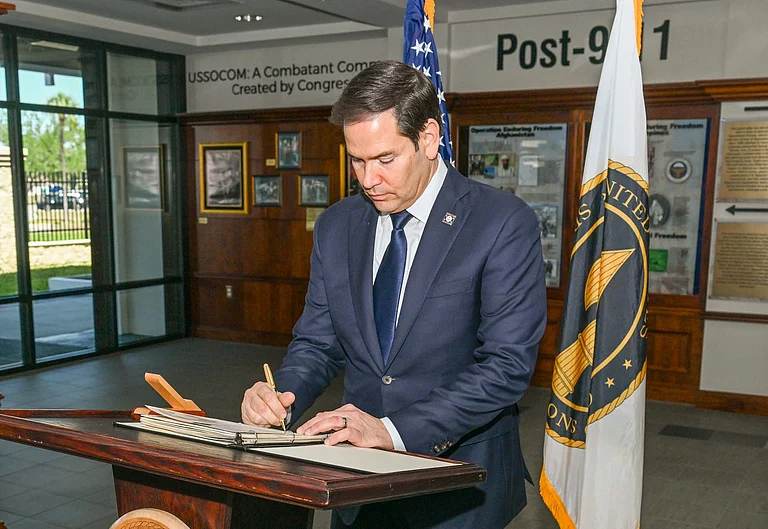NO single foreign policy development in the past 50 years has given Indians as great a shock as US president Bill Clintons decision to issue a joint statement with the Chinese president Jiang Zemin from Beijing devoted solely to condemning the Indian and Pakistani nuclear testsand offering China a partnership role in preventing "an accelerating nuclear arms and missile race in South Asia". This was heaping insult upon injury, for had China not transferred the trigger device and design of a nuclear bomb, ring magnets for gas centrifuges, at least 30 M-11 missiles and associated bomb and missile technology to Pakistan with a complete disregard for its own international obligations under the Nuclear Non-Proliferation Treaty, a situation might never have arisen in which it felt obliged to unveil and test its nuclear arsenal. Inviting China to solve a problem, when it was itself a part of the problem, was a travesty of justice. Not surprisingly, India condemned the joint statement in language that came close to being undiplomatic. Relations with the US sank to the lowest level they had ever reached.
During the US deputy secretary of state Strobe Talbotts visit to India last week, American diplomats tried to limit the damage by claiming that India had completely misunderstood Clintons purpose in involving China. What Clinton had tried to do in his talks with Jiang, was get him to agree not to supply any more weapons and missile technology to South Asia, i.e. Pakistan, and not take any action that might heighten confrontation there. This meant toning down the rhetoric in verbal exchanges with India and avoiding references to Kashmir. They also took pains to dispel the Indian misconception that Clinton had invited China to take part in settling the Kashmir dispute, and described the very idea as absurd. This was something only India and Pakistan could do.
These clarifications have gone a fair way towards repairing the breach in relations and have made it possible for India and the US to resume the dialogue to find a way to meet Indias now recognised security concerns within the framework of the global non-proliferation regime. But the breach that has opened between the US and India cannot be closed completely, because of the deeper implications of what President Clinton said and did in Beijing.
To highlight these, one has to ask just one simple question: what will the US do if China continues to transfer nuclear weapons and missile technology to Pakistan? Will it impose sanctions and move the UN Security Council and the G-7 to condemn China and join in the sanctions? Or will it once again try quiet, summit diplomacy to persuade China to respect its treaty obligations, while its spokespersons, Madeleine Albright downwards, maintain in public that China has not transferred any dangerous technologies to Pakistan in recent times? Few of us need to harbour any illusions as to which it will be.
This huge disparity in treatment does not stem simply from the US much larger trade with China, or the presence of a large number of American multinationals in that country; but from the enormous effort that Clinton has personally put into creating a global non-proliferation regime to the US liking, and his iron determination not to let anyone, let alone weak and indecisive India, bring it down in the last two years of his presidency.
Over the past seven years, the US administration and the powerful American intelligentsia have joined forces to persuade the world that the NPT is the best guarantor of peace in the next century. And to some extent this claim is not unjustified. Had there been no NPT, it is possible that some or all of countries like Germany, Japan, North and South Korea, Brazil, Argentina, Iran, Iraq and South Africa, not to mention Israel and the dozen or so new states spawned by the break-up of the Soviet Union, would have become, or remained, overtly nuclear states. It is also true that the larger the number of such states, the greater would have been the risk of a nuclear war being set off by accident.
But the main reason why the US is so intent upon punishing India and co-opting China is not the much-touted fear of an accidental nuclear war in South Asia, but because India has directly challenged the new international order that the US has been building since the end of the Cold War. This order is not even remotely democratic, but is a global oligarchy that comprised the nine nations that make up the P-5 and G-8, with the US at its apex. India has directly challenged this new international order just when the legal edifice that is to underpin its legitimacy is almost complete.
Looking back at the nineties, the painstaking steps the US has taken to build it are self-evident. In 1990 the G-7 was an informal summit designed solely to discuss economic issues. The P-5 was not a coherent political body because the Soviet Union was still intact and Cold War rivalry had still not quite ended, and because after Tiananmen, China was a political pariah. The implosion of the Soviet Union took care of one problem, but China still remained. Between 1993 and 1995 the Clinton administration tried to soften China by bullying it. China, for its part, looked around busily for allies who would help it to resist Washingtons global hegemonism. It was in this mood that it signed the Agreement on Peace and Tranquility in the border regions with India in 1993, to lay at rest the four-decades-old border dispute in the Himalayas.
In 1996, however, Clinton did a volte-face and embarked on a policy of constructive engagement with China. Accordingly all pressures were taken off and the doors of advanced technology were thrown wide open to it. At the same time, as a sop to make up for the eastward expansion of NATO, Russia was made a member of the G-7. In both cases the bait of power-sharing was used effectively to make them accept the reality that it resided almost entirely with the US.
Whatever else it might have done, the Indian nuclear test gave Clinton a windfall opportunity to consolidate the emerging power hierarchy. Clinton co-opted the till then somewhat reluctant Tony Blair by giving Britain the responsibility of whipping the EU together behind sanctions against India, and Jiang by offering China a partners status in containing the arms race in South Asia. India therefore remains far from convinced by the clarifications the Talbott team has given.























